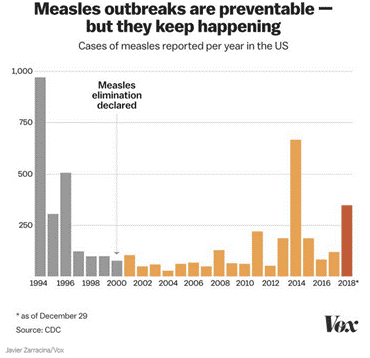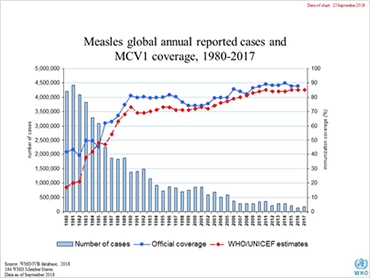Measles is on the rise globally across all regions. In Europe, over 41,000 children were infected in the first half of 2018 alone. In the US, the governor of Washington State declared a local public health emergency last week after a measles outbreak just outside of Portland, Oregon infected over 35 individuals, most of whom were unvaccinated. Considered all but eradicated in the U.S. just two decades ago due to widespread use of very effective vaccines, and declining worldwide, this potentially deadly disease has made a return. What can employers do to encourage vaccination amongst employees and their children? How can they go about increasing use of evidence-based vaccines for several diseases?
 What’s the Big Deal About Measles?
What’s the Big Deal About Measles?
- Before the introduction of a vaccine in 1963, there were almost 50,000 hospitalizations and 500 deaths each year in the U.S. due to measles. Measles deaths have decreased by 84% globally in recent years, but are still common in developing countries.
- The net cost of a single case of measles is over $10,000, which includes the cost of treatment for individuals and employers, as well as public health expenses for responses to contain its spread.
- For people who are unvaccinated, measles is extremely contagious, spread through the air or touch.
- The measles, mumps, and rubella (MMR) vaccine should be delivered before the age of 2 and the effects last for decades, but unvaccinated adults can still get vaccinated later in life.
Vaccination Rates on the Decline
Some people cannot get vaccinated for medical reasons, but in the U.S., the number of children receiving no vaccinations by the age of 2 is increasing as non-medical exceptions (NMEs) have risen in the past few years. Globally, vaccination rates vary by region but are increasingly becoming insufficient for herd immunity.
Unfounded claims that vaccines can cause autism has driven many parents toward not vaccinating their children. There is no evidence that this claim is accurate, but efforts to convince doubters otherwise have had little success.
Why would someone not vaccinate themselves or their children?
- Religious beliefs or philosophical reasons.
- Many states have begun to relax requirements for children to be vaccinated prior to entering kindergarten.

How Can Employers Increase Vaccination Rates?
- Conduct regular, targeted communication campaigns encouraging use of vaccines to parents, especially those in localities with significant outbreaks of measles, flu, or other vaccine preventable diseases. Key points of emphasis should include:
- Zero employee cost share for preventive treatment,
- CDC outlines on vaccine safety and effectiveness,
- The potential for measles or the flu to spread to loved ones like younger children, aging parents, and adults who cannot get vaccinated for medical reasons, and
- Vaccinations can be obtained at convenient sites of care like, pharmacies, their primary care provider, many retail clinics, and others.
- Provide vaccinations in on-site and near-site clinics for employees and dependents.
- In industries that provide medical or supportive care (e.g. daycare staff, education), employers should require documentation of recent MMR and annual flu vaccinations.
How Can Employers Prevent the Spread of Communicable Disease for Employees and Customers?
- When appropriate, be flexible and encourage employees to telework and take time off to prevent the spread of communicable diseases and continue business operations
- Implement paid sick leave and encourage employees to take time off when needed to prevent the spread of disease to other employees or customers.
- In Non-U.S. locations, ensure that vaccines are covered by either private health plans or the national/state health care system.
- Make sure globally mobile employees have all necessary vaccines before traveling.
